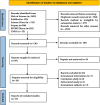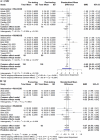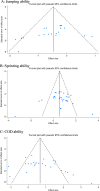The chronic effects of change of direction during repeated-sprint training on jumping, sprinting, and change-of-direction abilities in players: a systematic review and meta-analysis
- PMID: 40416610
- PMCID: PMC12101437
- DOI: 10.7717/peerj.19416
The chronic effects of change of direction during repeated-sprint training on jumping, sprinting, and change-of-direction abilities in players: a systematic review and meta-analysis
Abstract
Objectives: This systematic review and meta-analysis aimed to compare the effects of repeated sprint training with one change of direction (RS-OCOD) and multidirectional changes of direction (RS-MCOD) on players' jumping, sprinting, and change-of-direction (COD) ability.
Methods: Following PRISMA guidelines, 15 randomized controlled trials involving 223 players were analyzed. Standardized mean differences (SMD) and 95% confidence intervals (CI) were calculated using fixed- or random-effects models. Heterogeneity (I 2 statistic), publication bias (funnel plots and Egger's test), and sensitivity analyses were conducted. Subgroup analyses differentiated RS-OCOD and RS-MCOD outcomes.
Results: RS-COD training significantly improved countermovement jump (CMJ) (SMD = -0.68, 95% CI [-1.04 to -0.34]), 20-40 m sprinting ability (SMD = 0.70 [0.39, 1.01]), and COD ability (SMD = 0.77 [0.39, 1.16]). RS-MCOD demonstrated superior effects on 20-40 m sprinting ability (large effect: SMD = 0.97) and COD ability (large effect: SMD = 0.97), while RS-OCOD showed greater benefits for CMJ (large effect: SMD = -0.92). High heterogeneity (I 2 > 70%) was observed in 5 m/10 m sprint analyses, attributed to methodological diversity and age variability. Prediction intervals indicated potential overestimation of RS-MCOD effects.
Conclusion: RS-OCOD can significantly enhance a player's CMJ ability, while RS-MCOD can notably improve sprinting and COD abilities. These findings advocate for the incorporation of RS-COD into training programs to boost competitive performance. However, the effectiveness of RS-COD may vary based on the number and complexity of directional changes incorporated into the training regimen. Among them, RS-MCOD is prioritized for sports requiring frequent directional changes, whereas RS-OCOD enhances vertical jump performance in explosive sports.
Keywords: Explosive movement measures; Multidirectional sprint protocols; Neuromuscular adaptation.
©2025 Kong et al.
Conflict of interest statement
The authors declare there are no competing interests.
Figures







References
-
- Arede J, Poureghbali S, Freitas T, Fernandes J, Schoellhorn WI, Leite N. The effect of differential repeated sprint training on physical performance in female basketball players: a pilot study. International Journal of Environmental Research and Public Health. 2021;18(23):12616. doi: 10.3390/ijerph182312616. - DOI - PMC - PubMed
-
- Attene G, Nikolaidis PT, Bragazzi NL, Dello Iacono A, Pizzolato F, Zagatto AM, Dal Pupo J, Oggianu M, Migliaccio GM, Pacini EM, Padulo J. Repeated sprint ability in young basketball players (Part 2): the chronic effects of multidirection and of one change of direction are comparable in terms of physiological and performance responses. Frontiers in Physiology. 2016;7 doi: 10.3389/fphys.2016.00262. - DOI - PMC - PubMed
-
- Beato M, Bianchi M, Coratella G, Merlini M, Drust B. A single session of straight line and change-of-direction sprinting per week does not lead to different fitness improvements in elite young soccer players. Journal of Strength and Conditioning Research. 2019a;36(2):518–524. doi: 10.1519/JSC.0000000000003369. - DOI - PubMed
Publication types
MeSH terms
LinkOut - more resources
Full Text Sources

